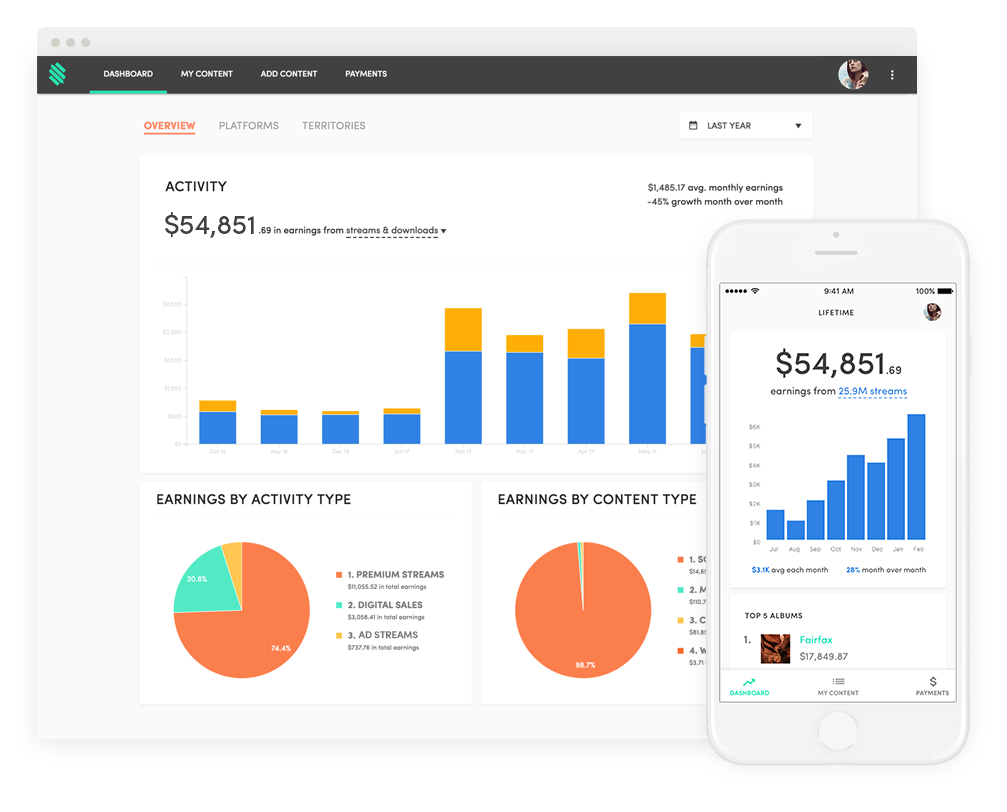Studio Business: Taking Control of Music Streaming Revenue with Stem
There’s a good reason that recording studios are increasingly adding a record label into their mix—actually a bunch of good reasons.
When studios and producers set up their own label, they create a chance at developing a longer-lasting connection with the artists who come through their doors. Instead of simply hosting some sessions, studios are extending their relationships with copacetic artists, so that they can keep on working with musicians they admire. In the optimum scenario, both sides realize additional revenue from sales, publishing, sync licensing and more.
As GSI Studios co-founder Daniel Rovin put it, “We take artists—who we call family—that we believe in and let them make the art they want to make… the (GSI Records) record label is at the heart of what we do.”
At the Boston non-profit studio, The Record Co, one of the flagship projects has been the Boston Sessions program, which releases compilations of artists that have recorded there—an initiative that got dozens of artists, engineers and producers paid.
There are also some great reasons for studios to NOT launch their own label. For a staff that can get overwhelmed just with the day-to-day business of recording, mixing and mastering, dumping a whole lot of red tape on top can feel anything but artistic. Contracts have to be signed, copyrights filed, PRO revenue chased down—and that’s just for starters.
The good news is that the rising tide of DIY tools that have been launched to make life easier for indie artists and labels happen to be a perfect fit for business-minded studios. Companies like Haawk, TuneRegistry, RoyaltyClaim, Audiam and Songtrust have made content monetization and unclaimed royalty collection tasks that are much easier for independents to take on.

LA-based Stem is a platform that tracks revenue streams and split earnings from music streaming services.
Another tool that studios and producers also need is for something that’s just as important, but perhaps easier to get their heads around.
Collecting revenue from streaming services like Apple Music, Spotify, Amazon, Google Play, and YouTube is key – after all, were talking about a music business vertical that increased 53% in 2017, resulting in $3.4 billion in revenue according to the Digital Media Association (DiMA).
That’s where the solution known as Stem comes in.
Co-founded by a trio of Los Angeles entrepreneurs fascinated by the cross-section of coding, commerce and music, their service is starting to look like a real success story two years in.
Their growing platform is focused on streamlining the reporting of earnings and precious data from music streaming services, so that song creators can easily upload content to those services, invite multiple shareholders, manage contracts, split up earnings, track performance data and revenue, and get paid every month.
Labels, music managers and artists are catching on. Co-founder Tim Luckow weighs here in on why Stem works for the evolving studio business model as well.
Business Name: Stem
Location: Los Angeles, CA
Launch Date: November 2016
Unique Offering: We make sure everyone involved with the creative process gets equal access to streaming data, and Stem pays all collaborators simultaneously based on confirmed splits. When a song/video is finished, you can upload to Stem, select platforms, add collaborators, and distribute that content to earn revenue from platforms.
Stem can be utilized by studios in many ways. One of the most straightforward ways is that studios using Stem can distribute content directly to platforms from the session after everybody in the room agrees to splits.
Now that the industry is moving at a faster pace, studios have an opportunity if they remove friction from the artists life, whether that be through offering direct distribution as part of their service, making sure all splits are encapsulated before the session ends and uploading as a draft, or creating new models based on revenue sharing with the artist and their team that make it easy to release large amounts of content without constant negotiation.
The AHA Moment: I realized Stem needed to be built when I started managing several groups and got a distribution deal, and that made my job harder instead of easier. That lead to learning more about writing code and building software, and the idea of building an independent solution from the ground up.
Research & Development: Creating Stem has been more challenging than I expected, mainly because of the complexities of growing an engineering team and because of that, building a foundational layer that we can now innovate on top of took longer than expected, but now we are there and can build the features and integrations we want to more efficiently.
The Percentage Model: [Stem gets paid 5% of revenue collected, rather than a flat fee.] I wanted to get away from the mentality that releasing creative content costs money as an action. So we don’t charge upfront for distribution, and the percentage model incentivizes everyone to get as many streams and downloads as possible.
Big Data: More demographic data helps make better decisions. Whether routing a tour or choosing which kind of ads to run, there is a lot of value in being data-driven.
Expansion Action: The number of releases is growing quickly every month as is the total volume of earnings flowing through the system into creator’s bank accounts.
Case In Point: Madame Gandhi released an album and when it came time to make a video, she gave a percentage of earnings to the videographer instead of paying upfront in cash. Now they both earn from their work together along with getting access to the streaming data to inform future releases.
When it comes to a scenario like this involving producers, studios, or mixers and artists, here’s my view: Basically anytime an artist would think of paying a few hundred to a few thousand dollars to someone else, they should instead give them a percentage of future earnings to incentivize the best work from everyone involved.
Music is My Muse: Music has always been a deep part of my life. I started playing bass early and spent my high school years in bands and college years at music school. From there, technology became a clear solution to my problems, so I spent years learning that craft. Now I try to combine them.
Why Being a Sonic Entrepreneur Rules: Getting to create your own destiny without excuses.
Why Some Days You Want to Pack It In and Get Your Real Estate License: There’s no safety net.
The Ultimate Business Partner: Robert Noyce, someone who will bring highly creative ideas that they have thought through to the table, and can also build and scale various engineering org structures.
Sage Advice: Stay humble, keep burn low, and invest in R&D early.
- David Weiss
Please note: When you buy products through links on this page, we may earn an affiliate commission.








